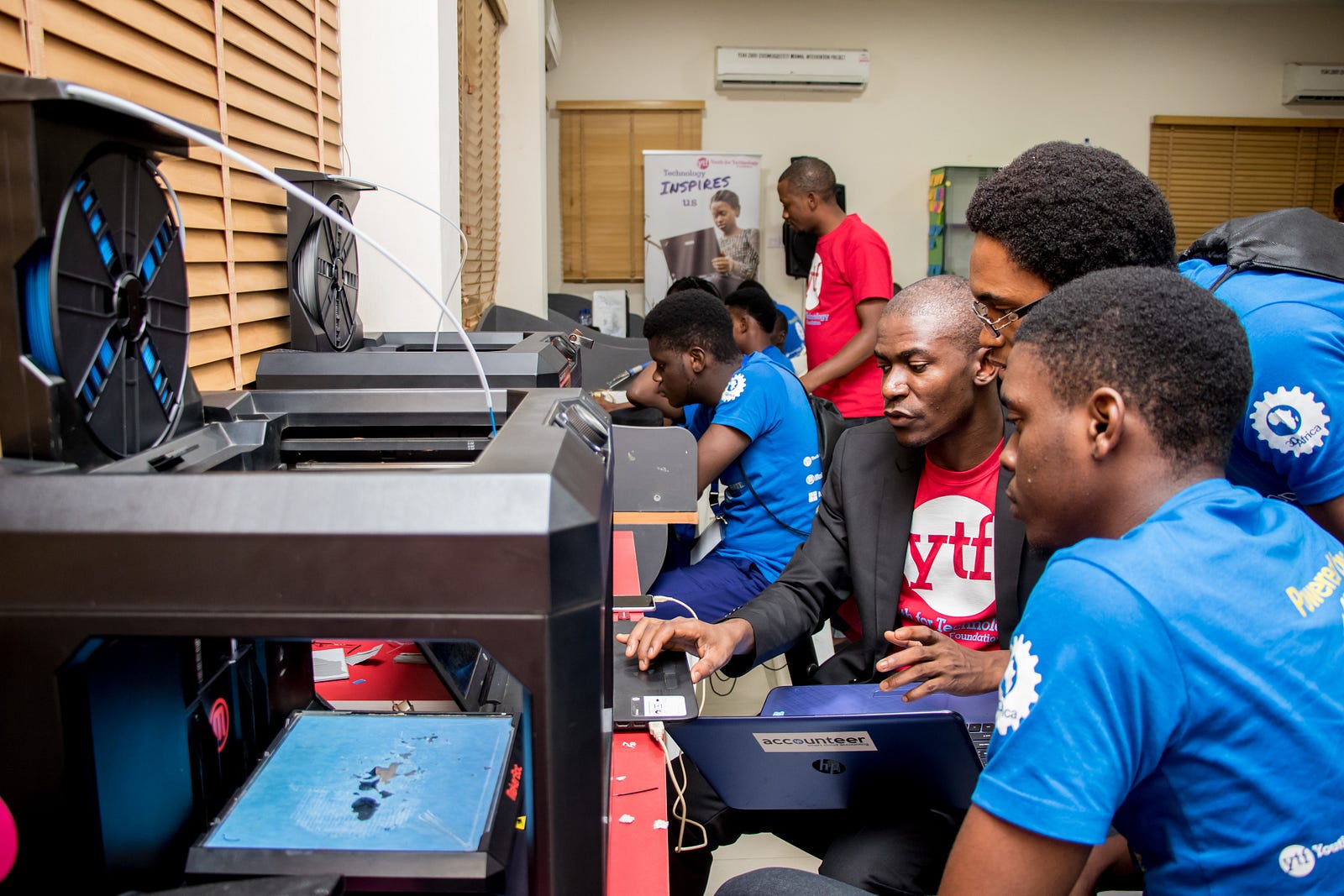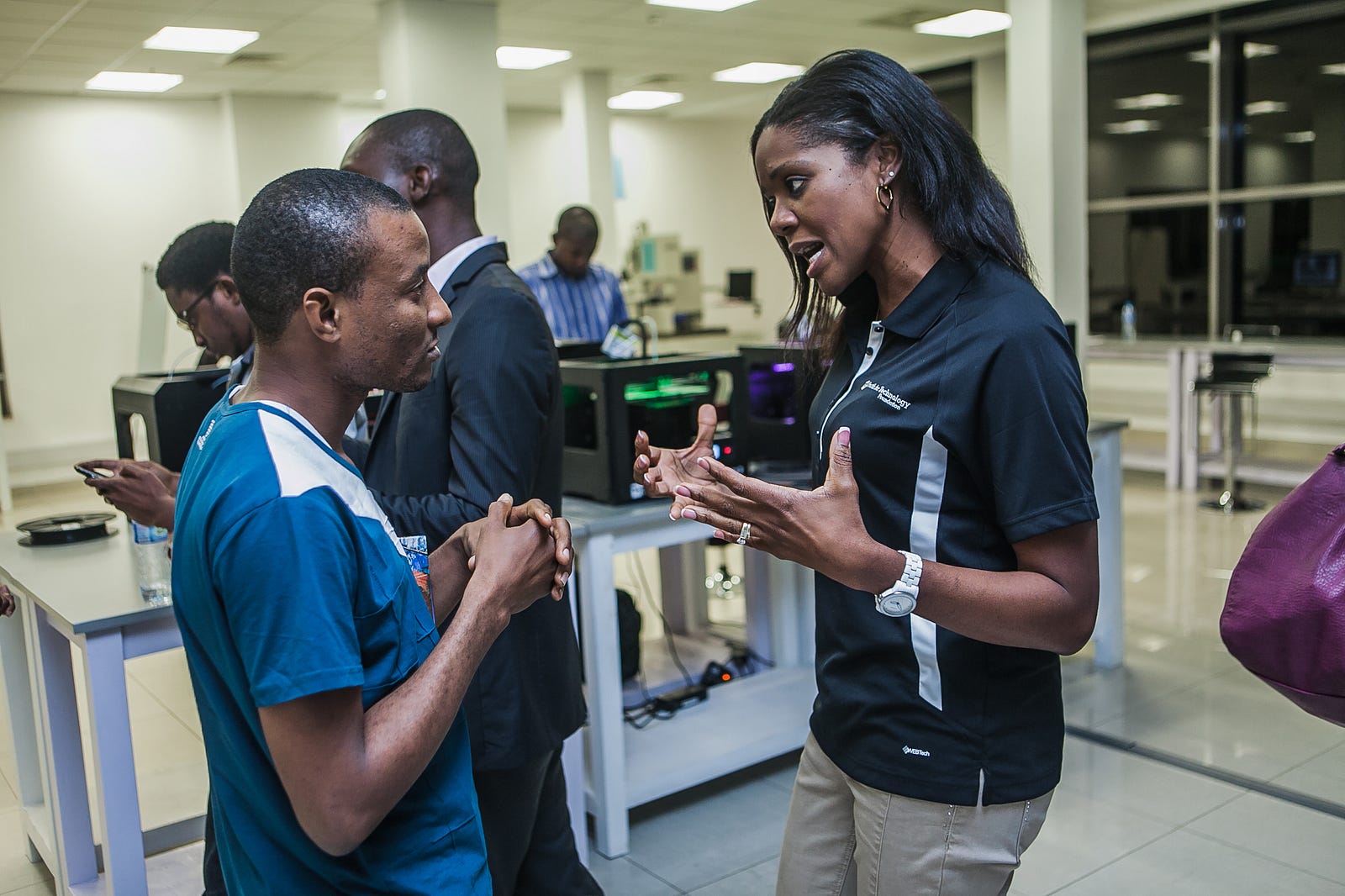At Youth for Technology Foundation (YTF), we are dedicated to positively impacting our people, our clients, and our communities by creating “new skilling” pathways for an inclusive future of work — a future in which all workers have the motivation, means, and opportunity to thrive in the digital economy. This is why when Hewlett-Packard (HP) invited us to co-author a 3D printing course on HP Life, we did.
YTF teaches emerging and disruptive technologies through 3D Africa, a platform that introduces human-centered design and 3D printing to students in schools and in innovation corridors and to entrepreneurs. Combining classroom, online, and business development training with support from corporate partners, 3D Africa provides an opportunity for underemployed and undereducated youth and for women entrepreneurs to replace economic disparity with economic opportunity.

At the annual meeting of the World Economic Forum in Davos last January, I announced YTF’s partnership with HP to co-author the 3D printing course available through HP Life so its exciting to actually bring this to life.
Why 3D Printing?
To any number of nontechnical people, 3D printing may sound like something of interest only to engineers. In reality, 3D printing offers innovative solutions to many practical business problems. 3D printing opens the door to your imagination. If you can dream it, you can design it and make it. 3D printing makes it possible to get exactly what you need — and to get it within hours or days, as opposed to weeks or months. If you are an inventor or designer, 3D printing enables you to produce prototypes of your designs quickly and efficiently. If you are an entrepreneur, 3D printing can help you bring products to market quickly, thus enabling you to grow and expand your business.
There are three primary benefits of 3D printing:
- For many small businesses in an array of industries (e.g., electronics, home decorating, and small-engine repair), 3D printing lowers barriers to entry into manufacturing.
- The ability to produce items through 3D printing on an as-needed basis decreases the need to maintain a large physical inventory.
- The ability to produce replacement parts through 3D printing can extend the useful life span of many products.
How We Did It
With the growth of 3D printing technology, accessible training has become even more critical. As the cost of 3D printers has decreased, the technology itself has become more widely available. Yet many entrepreneurs do not yet have the design skills to utilize the technology. The course is available to help entrepreneurs learn what they need to know to utilize 3D printing in their business.
The course was designed to be an hour long and Brenda Firquin, YTF’s Chief Learning Officer, led our teams to co-design and integrate feedback into the modules. Every step of the way, she emphasized the importance of the curriculum being learner-centered with clear learning objectives and expected learning outcomes.
The course starts with the objectives, a short summary, a review of the business concept, case studies, technology skills, and downloadables. The business concept section goes through the basic definition of 3D printing, how 3D printing differs from traditional manufacturing, the business opportunities that 3D printing offers to entrepreneurs, and the areas where 3D printing is being applied. The technology skills section highlights the skills and tools needed to create 3D designs and how to use a 3D printer to make an object. Three case studies of how entrepreneurs are using 3D printing are highlighted. These case studies show how 3D printing is being used for various purposes across industries, the effort and materials needed, how 3D printers are being accessed, and how they sell their products. In the coming months, the curriculum will be available in English, French, Spanish, Portuguese, Arabic, Hindi, and Chinese.
So, Who Cares?
The rapid growth of digital technologies has led to an ever increasing skills gap. People need jobs, and employers need workers; unfortunately, the people do not yet have the skills that the employers require for the jobs available. To bridge this skills gap, it is imperative that the private sector is in the classroom to give input into the curriculum. For this reason, YTF’s partnerships with private-sector firms are extremely important.
The 3D printing industry is projected to grow from $3.1 billion in 2013 to $30 billion in 2022. You should care.
During the course development, global teams from YTF and HP shared ideas, reviewed each stage of development, and critiqued the product. The final course is an example of how successful these combined efforts can be in building a world-class curriculum for varied geographies.
YTF has a deep amount of practical experience in working with individual entrepreneurs and small businesses in developing countries. We understand these entrepreneurs’ needs and the challenges they face. We also know how 3D printing technologies help address some of these challenges.
One of the case studies highlights Tochukwu, a 3D printing entrepreneur in Nigeria. I first met Tochukwu in 2014 in Lagos where I presented our work with 3D Africa to a room full of young entrepreneurs and aspiring technologists. YTF was the first social enterprise to implement 3D printing training in secondary schools and universities in Nigeria. For many of the participants, this was their first introduction into human centered design and 3D printing. Learning about our work and foray into this market left many with questions and wanting more information on how to get started.
Shortly after my presentation, Tochukwu introduced himself and asked several insightful questions. Shortly following, he worked closely with and was mentored by our 3D Africa program managers. Through this collaboration process he modeled and 3D printed a “reading stand” prototype for the ASME competition in Nairobi. Fast forward a few years, we are delighted and not surprised to learn that Tochukwu went on to establish a 3D printing innovation center. My team and I are proud to have played a part in Tochukwu’s successful journey to become a 3D printing entrepreneur.

In Africa today, most manufactured parts are imported and expensive. However, new supply-chain models can replace traditional suppliers with in-house printing of many parts. Thus, 3D printing can dramatically reduce costs.
McKinsey estimates that by the year 2020, two thirds of global demand will come from emerging markets. Technologies like 3D printing will put skills and income in the hands of people living in emerging economies.
Disruption is no longer confined to individual industries, countries, or regions in the fourth industrial revolution. Emerging technologies like 3D printing have the power to impact entire global structures. The most pressing need today is to help people develop skills, which is what 3D Africa set out to achieve.
We invite you to enroll in the course and earn your certificate. Then, complete the online evaluation form, to let us know what you think. If you are on the continent and have a prototype you want us to help 3D print for you, upload it to 3D Africa’s online printing service and we will be happy to work with you.
